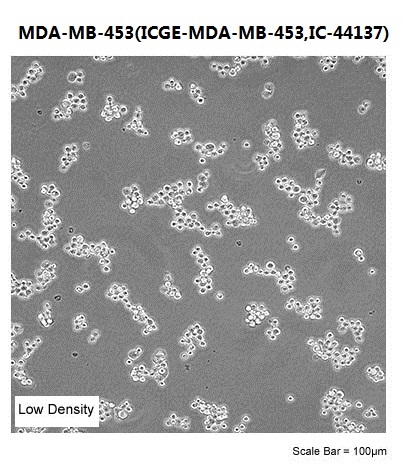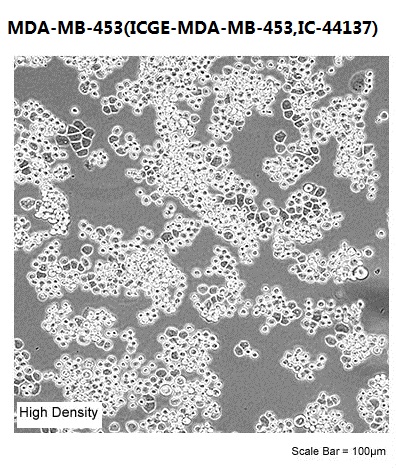


Overview
| Permits and Restrictions | |
|---|---|
| Organism | Homo sapiens, human |
| Tissue |
mammary gland/breast; derived from metastatic site: pericardial effusion
|
| Product Format | frozen |
| Morphology | epithelial |
| Culture Properties | adherent |
| Biosafety Level |
1
Biosafety classification is based on U.S. Public Health Service Guidelines, it is the responsibility of the customer to ensure that their facilities comply with biosafety regulations for their own country. |
| Disease | metastatic carcinoma |
| Age | 48 years |
| Gender | female |
| Ethnicity | Caucasian |
| Applications |
This cell line is a suitable transfection host.
|
| Storage Conditions | liquid nitrogen vapor phase |
Properties
| Karyotype |
modal number = 90; range = 87 to 91. The cell line is aneuploid human female, with chromosome counts in the hypo- to near-tetraploid range. Normal chromosomes N11, N13, and N17 are absent, and chromosomes N2, N6, and N12 are clearly under-represented with respect to the copy number of other normal chromosomes, while chromosome N20 tends towards over-representation. A large number of marker chromosomes are present with consistency, many of them with more than one copy. The near-diploid population of cells reported for this culture has been replaced by a tetraploid population. |
|---|---|
|
|
|
| Derivation |
MDA-MB-453 was derived in 1976 by R. Cailleau et al. from an effusion of a 48 year old female patient with metastatic carcinoma of the breast, involving the nodes, brain and both pleural and pericardial cavities.
|
| Clinical Data |
48 years
Caucasian
female
|
| Receptor Expression |
fibroblast growth factor (FGF), expressed |
| Tumorigenic | No |
| Effects |
No, in immunosuppressed mice
Yes, in semisolid medium
|
| Comments |
The cells overexpress FGF receptors.
|
Background
| Complete Growth Medium |
The base medium for this cell line is ATCC-formulated Leibovitz''''''''s L-15 Medium, Catalog No. 30-2008. To make the complete growth medium, add the following components to the base medium: fetal bovine serum to a final concentration of 10%.
(Note: The L-15 medium formulation was devised for use in a free gas exchange with atmospheric air. A CO2 and air mixture is detrimental to cells when using this medium for cultivation) |
|---|---|
| Subculturing |
Volumes are given for a 75 cm2 flask. Increase or decrease the amount of dissociation medium needed proportionally for culture vessels of other sizes. Corning® T-75 flasks (catalog #430641) are recommended for subculturing this product.
Subcultivation Ratio: A subcultivation ratio of 1:2 to 1:6 is recommended
Medium Renewal: 2 to 3 times per week
|
| Cryopreservation |
Freeze medium: Complete growth medium supplemented with 5% (v/v) DMSO
Storage temperature: liquid nitrogen vapor phase
|
| Culture Conditions |
Atmosphere: air, 100%
Temperature: 37.0��C
|


